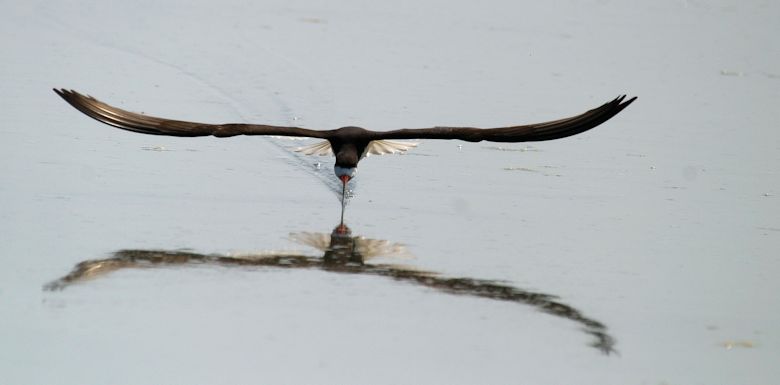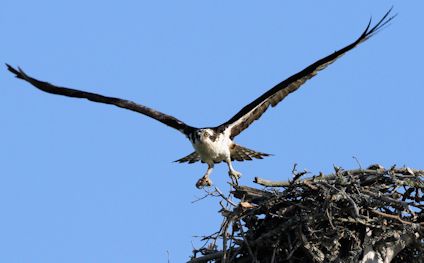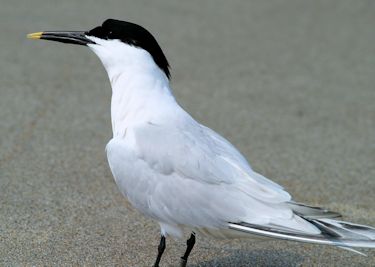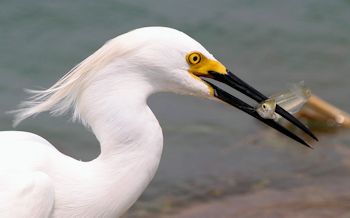
The remarkable bill of the black skimmer sets it apart from all other American birds. The large red and black bill is knife-thin and the lower mandible is longer than the upper. The bird drags the lower bill through the water as it flies along, hoping to catch small fish.
Supporter Spotlight
 Unique among North American raptors for its diet of live fish and ability to dive into water to catch them, ospreys are common sights soaring over shorelines, patrolling waterways and standing on their huge stick nests, white heads gleaming. |
SWANSBORO — What could be finer than birding by boat in Carolina in the fall?
Quite possibly nothing, especially if the boat-riding and bird-watching is in and around the nearly pristine and picturesque marshes and islands in the White Oak River and Bogue Sound near Swansboro and Hammocks Beach State Park.
Local bird expert Joanne Powell, with more than 40 years of experience in the region, will guide N.C. Coastal Federation birding cruises – one each in September, October and November – and she says participants are almost guaranteed to see something special: birds, other wildlife or just stunning beauty.
“Fall is a great time for birding here,” she said. “We should see a really wide variety of shorebirds, from herons and egrets to oystercatchers and the smaller birds, such as willets. There will also be plenty of gulls, of course. We’ll probably see all of the five species that are here.
“By the November trip,” Powell continued, “We should start seeing the waterfowl: mergansers, cormorants and others. You never know for sure, but once the cooler weather starts, they should be here.”
Supporter Spotlight
Photos by Sam Bland |
The trips will begin at 10 a.m. each morning and will end by noon. Participants will meet at Hammocks Beach State Park in Swansboro and are asked to bring their own binoculars, as well as water and a snack, and to dress appropriately for the weather. Admittedly, that can be a bit tough in October and November, when temperatures and winds can vary daily, if not hourly, but generally temperatures are mild enough for light jackets. The program fee is $20 per person. All ages are welcome, though the program is geared toward adults and older children.
Powell says the trips will be excellent for beginning birders, and she knows her stuff. She’s lived on the coast since 1970 and is the former education curator for the N.C. Maritime Museum in Beaufort.
“When I started working with the museum, I was really fortunate to be able to incorporate birding into my work.” Powell said. “I’ve also done a good bit of international birding. It has been a great adventure.”
 Royal terns feed primarily on fish rather than crabs, more than any other tern. The offering of fish by the male to the female is part of the courtship display.A group of royal terns, by the way, is collectively known as a “highness” of terns. |
 The Sandwich tern was originally described by ornithologist John Latham in 1787. The current genus name is derived from the Greek Thalassa, “sea”, and sandvicensis refers to Sandwich, Kent, Latham’s home. A group of these terns is known as a “hogey” of terns. |
Powell said it’s easy to get hooked on birding, because it’s relatively inexpensive (unless you get so hooked you wander around the world) and doesn’t have to be physically demanding.
“Once you’ve made the initial investment in a good pair of binoculars and maybe a good field guide, you don’t have to spend much money, and it’s just great entertainment,” she said. “Once you get into birding, one of the best things is that no matter where you go, you can be entertained.
“That’s true whether you’re on trips or just at your own house, with a couple of birdfeeders close enough to your windows,” Powell added. “If you do go out in the field, you’re going to see something new every time. Even if you see birds you’ve already seen, you are going to see them in a different place, in different light. It is a new experience each time.”
Many, if not most, birders end up combining bird-watching with photography, and that’s easier than ever now with lightweight and relatively inexpensive digital cameras. You can download your photos to your computer, print them and use your own art to shape your home décor. Many birders become excellent photographers.
Many people get deeply into birding pretty fast, and start compiling “life lists,” recording all of the species they have seen in their lives, complete with details about the date, location and conditions. Powell said she doesn’t do that, but it’s obvious she knows as much about birds as those more obsessed folks. Just ask her a question about sea gulls, like, “After one of these cruises, will people be able to tell the difference between the five species you see in North Carolina?”
“They will learn how to tell the difference, but whether they will be able to actually do it right away… Put it this way, when the birds are in their adult plumage, it can be easy, but some go through three years of getting their adult plumage and they are different each year. And the laughing gull changes as an adult. In the summer, they have a black hood, but in the winter it’s gray.”
What all this means, Powell said, is that while there are only five species of gull likely to be seen, to a novice or casual observer, it can appear more like 20.
But neither keeping a life list nor the ability to positively identify each gull in each season and stage of life is necessary for birding to be fun, and that’s particularly true of these cruises.
 Among the most elegant of the herons, the slender snowy egret sets off immaculate white plumage with black legs and brilliant yellow feet. That long beak is quite adept at catching fish. Among the most elegant of the herons, the slender snowy egret sets off immaculate white plumage with black legs and brilliant yellow feet. That long beak is quite adept at catching fish. |
“Some people just enjoying going out on a boat ride and seeing the environment,” she said.
And birds are not, of course, all you will see. The White Oak is one of the state’s most unique and beautiful rivers, and boasts some of the best and least spoiled marine habitats in the state. Seeing that is obviously a major reason the federation got involved in the trips.
“Part of the purpose is just for people to see this wonderful coastal environment,” Powell said. “I can explain the marsh environment and coastal ecology, and will answer questions. These trips fit right in with the Coastal Federation’s mission,” part of which is creating new and hopefully lifelong stewards of the coastal environment. One trip in the White Oak is often enough to start that process.
Powell has long been a supporter of the federation, and has begun volunteering more with the organization since she retired.
“I can’t say enough about the organization and what it’s done for the coastal environment,” she said. “It’s fun and meaningful for me to get out and tell people about the federation’s great work.”
For more information about the trips, contact Sarah Phillips by email or by phone at 252-393-8185.
To register for a cruise, go to the Events Calendar on the federation’s Web site.







